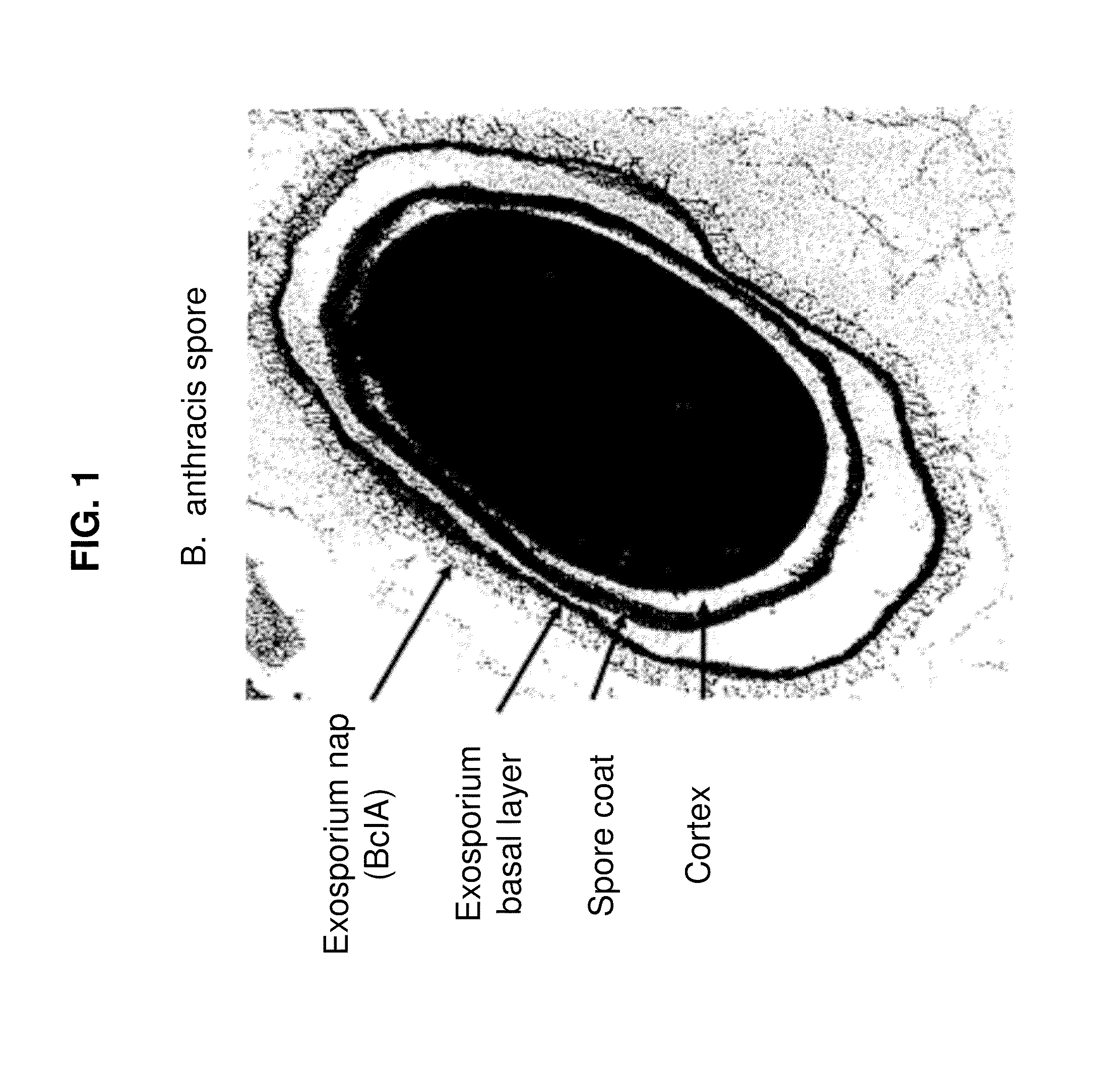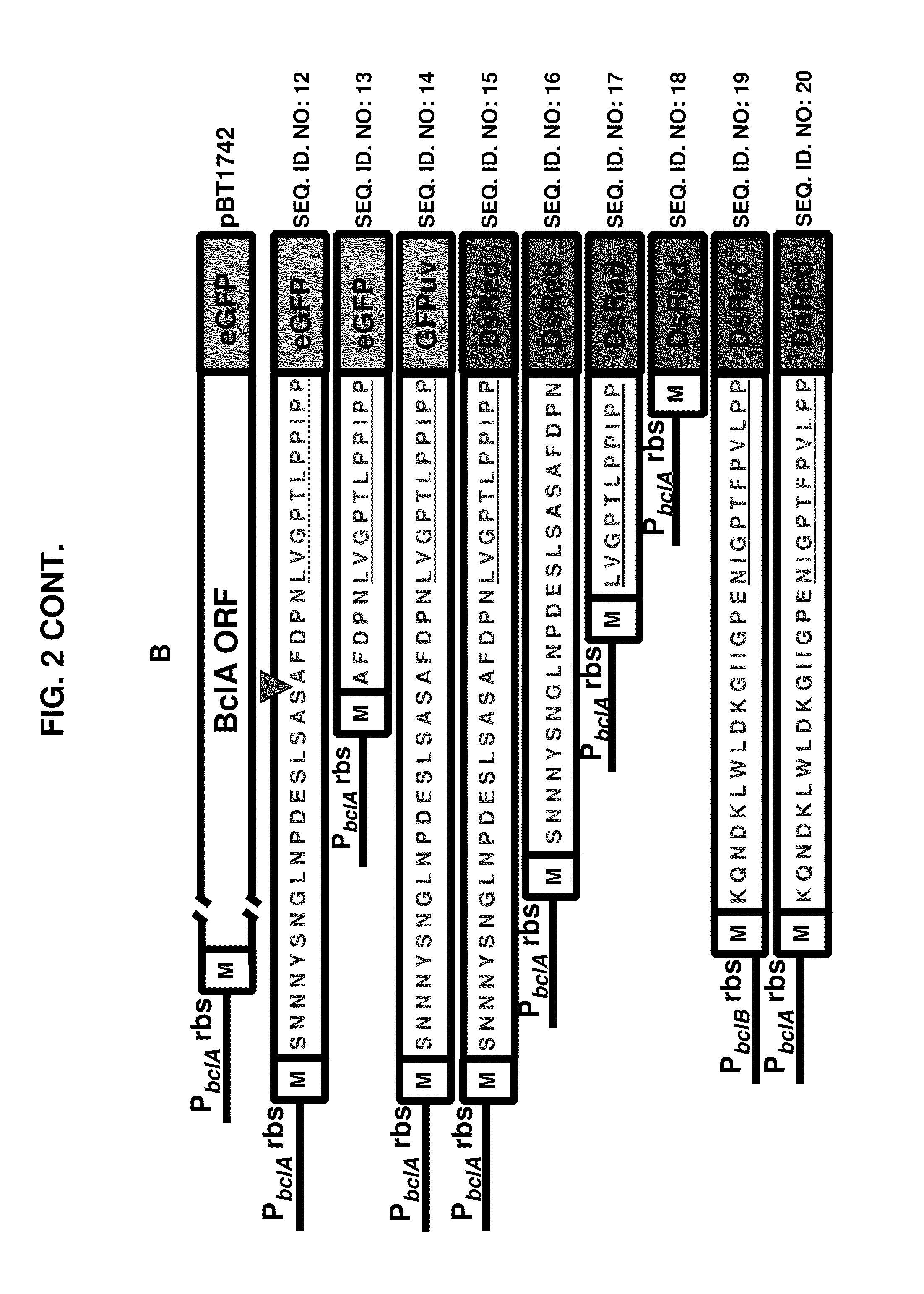Bacillus based delivery system and methods of use
a technology of bacillus and bacillus, which is applied in the field of i > bacillus /i > based delivery system and methods of use, can solve the problems of unfavorable i>b. cereus /i>family function and relative little is known about the exosporium layer
- Summary
- Abstract
- Description
- Claims
- Application Information
AI Technical Summary
Benefits of technology
Problems solved by technology
Method used
Image
Examples
example 1
The BclA Protein Contains An N-Terminal Exosporium Targeting Domain
[0064]Given that the BclA protein associates with the exosporium via its N-terminus, this N-terminal conserved sequence, SEQ ID NO: 11 (see FIG. 2A), was investigated for the possible targeting of BclA and other collagen-like proteins to the exosporium.
[0065]To determine if the N-terminal domain of BclA is sufficient to target the native protein to the exosporium, two gene fusions were generated to the eGFP fluorescent reporter. PCR amplification of the upstream promoter / regulatory sequences of bclA and including the N-terminus coding sequence through the conserved motif or the entire bclA coding sequence was performed. These PCR products were then spliced with the eGFP reporter gene to produce in-frame fusions (FIG. 2B). The DNA constructs were subcloned into the pMK4 shuttle plasmid using known techniques (see Sullivan et al., 1984) and introduced into the plasmid-free ΔSterne strain of B. anthracis by electroporat...
example 2
N-Terminal Amino Acids Required For Exosporium Incorporation
[0068]BclA released from spores lack its N-terminal 19 amino acids (Sylvestre et al., 2002; Steichen et al., 2003). It is unknown whether the proteolytic event resulting in the loss of these N-terminal residues takes place during exosporium assembly and BclA incorporation, or occurs after BclA has been stably inserted into the exosporium layer. To determine whether these initial N-terminal amino acids are required for efficient incorporation into the exosporium, a third fusion (pBT1750) was constructed, containing the bclA promoter region, RBS, through the bclA initiation codon followed by the coding sequence for amino acids 20-35 of BclA fused to the eGFP coding sequence (see FIG. 2B). This construct mimics the spore-extracted form of BclA (differing only by the presence of the N-terminal methionine residue), and allows for examination of the role of the truncated N-terminus in incorporation of BclA (FIG. 4K-4O). The pBT17...
example 3
Cleavage of the N-Terminal Domain Associates With Incorporation of BclA Into the Exosporium
[0071]The attachment of the pBT1750-encoded fusion implied that the truncated BclA can be recognized and attached to the exosporium. To address the question of whether cleavage of the intact BclA N-terminal domain occurs during exosporium formation, a dual reporter fusion construct was made. The pBT1758-encoded fusion consists of the bclA promoter followed by the mCherry monomeric reporter gene (Shaner et al., 2005; Giepmans et al., 2006) fused in frame to the BclA N-terminal domain that was in turn fused in frame to the GFPuv reporter (FIG. 5A). This fusion allows for the analysis of cleavage in the N-terminal domain (NTD) by appearance of separation between the red fluorescence and green fluorescence of the reporter proteins.
[0072]Similar to the findings with the single-reporter fusions, the pBT1758 fusion appeared in the mother cell cytoplasm prior to the appearance of the emerging spore (F...
PUM
| Property | Measurement | Unit |
|---|---|---|
| size | aaaaa | aaaaa |
| thickness | aaaaa | aaaaa |
| compositions | aaaaa | aaaaa |
Abstract
Description
Claims
Application Information
 Login to View More
Login to View More - R&D
- Intellectual Property
- Life Sciences
- Materials
- Tech Scout
- Unparalleled Data Quality
- Higher Quality Content
- 60% Fewer Hallucinations
Browse by: Latest US Patents, China's latest patents, Technical Efficacy Thesaurus, Application Domain, Technology Topic, Popular Technical Reports.
© 2025 PatSnap. All rights reserved.Legal|Privacy policy|Modern Slavery Act Transparency Statement|Sitemap|About US| Contact US: help@patsnap.com



